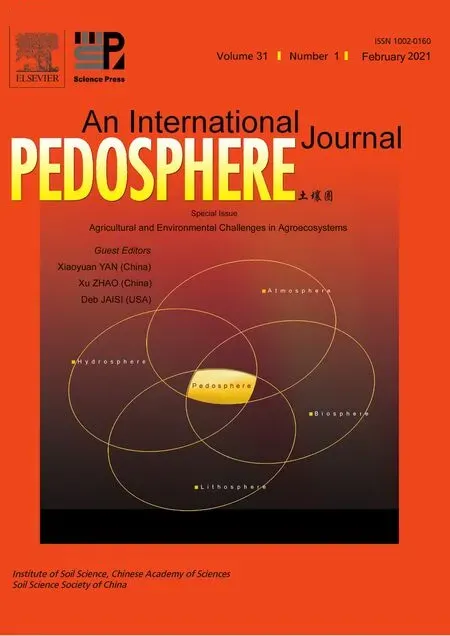Global patterns of phosphorus transformation in relation to latitude,temperature and precipitation
2021-03-17Jia-ZhongZHANG
Dear Editor,
Phosphorus(P)is essential and often a limiting nutrient for biological production on land and in the seas(Elseret al.,2007).The biologically available P to terrestrial and aquatic ecosystems ultimately derives from the continental weathering of rocks on the surface of the earth(Föllmi,1996;Ruttenberg,2003).Rocks are usually classified into three groups based on their origins:igneous,metamorphic,and sedimentary rocks.Although tectonic activity continually cycles the three rocks into each other,igneous rocks are the primary source rocks because they are formedviacooling and hardening of lava from the mantle and are a dominant rock pool,accounting for 65% of the mass,in the crust.Both sedimentary and metamorphic rocks are considered as secondary rocks.Sedimentary rocks are formedviaaccumulation of sediments derived from the weathering of pre-existing rocks and erosion of surface soils and often contain organic material of biological origin.Metamorphic rocks are formedviasubduction of all rock types deep into the crust where they undergo metamorphisms under high pressure and temperature.Therefore,all the rocks currently present in the crust are believed to have first been igneous from the mantle.All the P that cycles through sedimentary rocks and biological systems must have been initially derived from continental weathering of crystalline rocks of igneous or metamorphic origin(Guidryet al.,2000;Horton,2015).
The physicochemical characteristics of rock-forming mineral are often used to trace the origin of rock.The igneous and metamorphic rocks contain minerals that are formed under high temperature and pressure.In contrast,sedimentary rocks are formed in typical near-surface environments under low temperature and pressure.Many detritus minerals in sedimentary rocks are left over from pre-existing igneous and metamorphic rocks.Therefore,an understanding of the mineral composition of soil and sediment can provide the information needed to unlock the weathering processes in their source regions.The apatite family is the most abundant in the P-con-taining mineral among all rock types,with a general chemical composition as represented by the formula Ca10(PO4)6(OH,F,Cl)2.Different geological processes can induce variations in the OH,F,and Cl contents,resulting in different chemical stability within the apatite family members(Changet al.,1998).In igneous rocks,F content increases as a result of fractional crystallization,and then fluorapatites become a dominant form(Nash,1984).Apatites containing OH and Cl groups are more abundant in lessfractionated rock types.Sedimentary rocks are dominated by carbonate fluorapatites(CFAs)or francolites derived from the substitution of PO4with CO3(Nash,1984;Changet al.,1998).
Crystal structure and bonding energy control the chemical stability of the apatite family.In fluorapatite,two crystallographically different Ca atoms occupy different sites:one in seven-fold and the other in nine-fold coordination.Each F atom is surrounded by three Ca atoms,and Ca-O columns are linked with a hexagonal packed sphere of PO4group.The lengths of Ca-X(X=F,OH,or Cl)bond increase from F to OH and further to Cl(0.2311 nm for Ca-F in fluorapatite,0.2385 nm for Ca-OH in hydroxyapatite,and 0.2759 nm for Ca-Cl in chlorapatite)(Hugheset al.,1989).This bonding arrangement provides the most stable structure for fluorapatite.In contrast,the structures of hydroxyapatite and chlorapatite are stretched;thus,hydroxyapatites and chlorapatites are less stable.The chemical structures suggest that fluorapatites are the most resistant to weathering attack among the apatite family members.In contrast,bonding symmetry is distorted in CFAs as a result of carbonate substitution at phosphate site.This has been proved experimentally in kinetic studies on dissolution of igneous fluorapatites(IFAs)and sedimentary CFAs in aqueous solutions over a range of pH values(Guidry and MacKenzie,2003;Chaïratet al.,2007a,b).
Fluorapatites have been found to be the most common member of apatite family in the igneous rocks.As an earlyformed,ubiquitous accessory mineral,IFAs are the principal repository of P in all igneous rocks.During weathering processes,IFAs are dissolved to release phosphate ions in aqueous solution,which are rapidly adsorbed to metal(Fe,Mn,Al,and Ca)oxides contained in soil and sediment or are assimilated into microbial and plant biomass.As soil ages,P might be transformed into CFAs and refractory organic P(Walker and Syers,1976).
Based on the chronosequence of pedogenesis studies performed in New Zealand,Walker and Syers(1976)developed a conceptual model to simulate temporal changes in soil P pools as a function of soil age.They postulated that at the beginning of soil development,all soil P is in primary mineral forms,mainly as calcium phosphate.As soil develops over time,the primary minerals weather rapidly and transform to occluded,non-occluded,and organic P,while total soil P declines due to leaching.Their model prediction suggested that at the late stage of soil development,soil P is low and is dominated by organic and occluded P.This conceptual model has been validated by numerous chronosequence studies in various ecosystems.Among these studies,the most convincing is the one demonstrating changes in soil P in the islands of Hawaii with soil age spanning thousands to millions of years as the volcanic islands were formed by the movement of the Pacific Plate over a stationary hotspot,a convective plume in the mantle,for millions of years,but under a similar subtropical oceanic climate(Crewset al.,1995;Vitouseket al.,1997;Chadwicket al.,1999).However,it should be noted that in all these chronosequence studies,the total apatite family was quantified as the socalled primary mineral P or apatite P since their sequential extraction methods used for fractionation of soil P pools did not distinguish between IFA and sedimentary CFA.
Sequential extraction has been an essential tool in all chronosequence studies to identify the forms of particulate P in soil and their evolution as a result of continental weathering and soil development on the surface of earth.It is a selective leaching procedure based on chemical reactivity of different solid P phases.The Hedley sequential extraction method has been widely used in the soil community(Hedleyet al.,1982;Cross and Schlesinger,1995;Tiessen and Moir,2008;Yang and Post,2011;Houet al.,2016,2018a).In this method,soil P sequential extraction consists of five steps.In the first step,anion resin is used to extract exchangeable inorganic phosphate,followed by treatment with NaHCO3solution(pH 8.5)to extract inorganic and organic P.In the third step,0.1 mol L−1NaOH solution is used for Fe and Al-bound P(occluded P),followed by treatment with 1 mol L−1HCl solution for biogenic and detrital apatites.The final step is the digestion of residual solid sample in a strong acid with oxidants added to decompose refractory organic P.Many variations of this method currently used in soil analysis do not include a weak acid extraction step;thus,different forms of calcium phosphate,all together,are dissolved in a strong acid(i.e.,1.0 mol L−1HCl or 0.5 mol L−1H2SO4).The caveat of these is,therefore,not making any distinction between biogenic/authigenic apatites and fluorapatites of igneous and metamorphic origins.
In order to quantify the authigenic CFA pool in marine sediments,Ruttenberg(1992)developed a sequential extraction method,the SEDEX method,in which a buffer solution of NH4Ac(pH 4)extraction step is added to dissolve biogenic apatites before using 1 mol L−1HCl to extract crystalline detrital apatites.The added step is Step 3 in the flow diagram in Fig.1.The advantage of this method over the Hedley method is its ability to distinguish between CFA and detrital apatite of igneous or metamorphic origin(IFA).In the Hedley method,CFAs and IFAs are extracted together in a single strong acid step and are collectively called primary mineral P(Houet al.,2018a).Although both CFAs and IFAs contain Ca and P as major elemental components,they have different biogeochemical origins and reactivities.Only the SEDEX method can separately quantify CFAs and IFAs in soil and sediment samples.Since IFAs are the primary P form in the igneous rocks at the beginning of weathering processes and their contents decrease progressively during the course of rock weathering and soil development,the absolute IFA content reflects the unweathered primary mineral P pool.All other forms of P are the products of transformation from original IFAs during weathering and soil development.The abundance of IFA relative to total P(TP)therefore reflects the status and extent(intensity and duration)of weathering in the study regions.In the subduction zone,IFAs remain in sediment,representing the pool of P escaping the biogeochemical cycle at the surface of earth,and eventually subduct into the mantle during rock tectonic cycles.
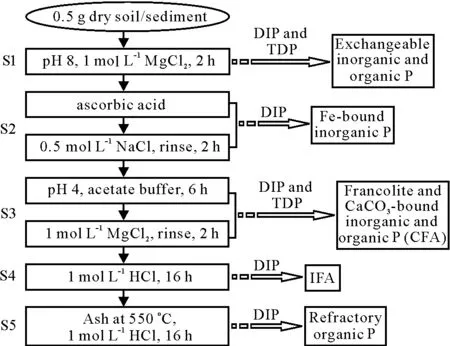
Fig.1 Flow diagram of solid phase P fractionation(5 steps,S1-S5)using the SEDEX method(Ruttenberg,1992;Zhang and Lanning,2018)for soil and sediment samples:a solid sample(0.5 g,ground to<125µm)is sequentially extracted with 50 mL solutions of increasing reactivity at 25◦C,and at the end of the extraction step,particles are separated from solution.The vertical arrows indicate the sequence of extraction with the particulate residue from a previous step,and the horizontal arrows indicate the required P measurements in solution phase after separation by filtration.Dissolved organic P is calculated as the difference between total dissolved P(TDP)and dissolved inorganic P(DIP).CFA=carbonate fluorapatite;IFA=igneous fluorapatite.
Many previous studies have shown the effect of soil age on P transformation at ecosystem scales.These studies focused on the time dependence and kinetic nature of the weathering processes at local scales.Some recent studies have shown the effect of climate on P transformation at regional scales(Filippelli and Souch,1999;Zhanget al.,2005;Fenget al.,2016;Sieberset al.,2017),and analyses of global soil available P data using the Hedley method have demonstrated that soil available P is significantly affected by climate(Sieberset al.,2017;Houet al.,2018b).Because of the inherent limitations of the Hedley method mentioned above,global patterns of P transformation in relation to climate forcing remain elusive.Here,we compiled an independent SEDEX dataset from the literature to identify the patterns of P transformation at the global scale in relation to climatic indices,such as absolute latitude(AL),mean annual temperature(MAT),and mean annual precipitation(MAP).This study will reveal how changes in TP,CFA,and IFA pools are related to climate conditions at the global scale.
The data used in this study were compiled from the published studies citing Ruttenberg(1992)through the Web of Science and Google Scholar search engines.To ensure data comparability,we used only data from the studies that reported solid phase P speciation analysis using the SEDEX method of Ruttenberg(1992)and the subsequent modifications(e.g.,Zhanget al.,2004,2010;Zhang and Lanning,2018).The advantage of these methods is the separation of IFAs from CFAs,as the former were the primary mineral and the latter are a weathering product.To discount the effect of anthropogenic influence on the natural P cycle,we limited our data to those studies which were located in the natural ecosystems on land and coastal waters in the continental shelf and did not include data from agricultural lands and aquatic systems that have been subjected to the impact of fertilizer application and wastewater discharge.To be representative of contemporary conditions on the surface of earth at a time scale of centuries,only samples taken from surface soil and sediment were used.In total,the database was drawn from 40 studies encompassing soils from North America(Levy and Schlesinger,1999),Australia(Samadi and Gilkes,1998),and Asia(Akhtaret al.,2014;Mehmoodet al.,2018),deserts soils from Asia(Guoet al.,2011),Africa(Hudson-Edwardset al.,2014),and North America(Zhanget al.,2018),and sediments from rivers including the Amazon River(Berner and Rao,1994),the Yangtze River(Rao and Berner,1997;Heet al.,2009;Houet al.,2009;Ranet al.,2016),and the Yellow River(Yaoet al.,2016),lakes(Njenga,2005;Songet al.,2013),and estuarine and coastal waters(Ruttenberg and Berner,1993;Vinket al.,1997;Eijsinket al.,2000;Schenau and De Lange,2001;Liuet al.,2004,2016;Zhanget al.,2004,2010,2016;Fanget al.,2007;Monbetet al.,2007;Virtasalo and Kotilainen,2008;Yuet al.,2012;Berbel and Braga,2014;Conget al.,2014;Menget al.,2014;Zhuanget al.,2014;Song and Liu,2015;Yanget al.,2016,2017,2018;Kanget al.,2017;Sudheeshet al.,2017;Bastamiet al.,2018).Surface sediment samples contain soil particles derived from the recent erosion of adjacent land surfaces;therefore,they contain the integrated weathering signals from the drainage basins of the studied rivers at a contemporary time scale.The sampling locations are shown in Fig.2.The MAT and MAP data for each sampling site were extracted from original studies or,in absence of these data,from the WorldClim dataset(version 1.4).Pearson correlation analysis was carried out to quantify relationships between the contents of different P forms and AL,MAT,and MAP.As AL is linearly correlated with MAT,multiple linear regression was used to analyze correlations between the contents of different P forms and long-term MAT and MAP.
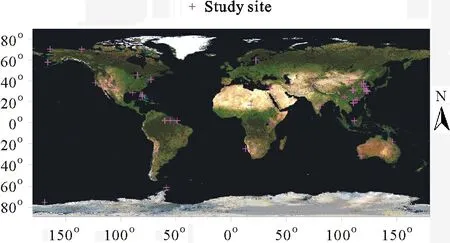
Fig.2 Global distribution of samples used in the studies using the SEDEX method,a sequential extraction method developed by Ruttenberg(1992).
As shown in Fig.1,the SEDEX dataset contains 40 studies distributed around the globe.These studies encompassed natural soils from deserts in Asia,Africa,and North America and sediments from lakes,rivers,and coastal waters.The river,lake,and coastal water sediments represent the integrated records of weathering in the drainage basins.In this dataset,the contents of TP in soil and sediment vary from 1.17µmol g−1in tropical Indonesia(Levy and Schlesinger,1999)to 42.73µmol g−1on an Antarctic island(Berbel and Braga,2014).In general,TP contents are low in the tropics and high in the high-latitude regions.The TP contents increase with AL,showing a significant positive correlation(R2=0.5377,P<0.001)(Table I,Fig.3).In contrast,the TP contents decrease with local MAT,showing a significant negative correlation(R2=0.6031,P<0.001)(Table I,Fig.3).This is consistent with results from previous regional studies in China,in which high TP contents were observed in cold,high-latitude regions,particularly in the frigid Taklamakan Desert,and low TP contents were observed in hot,tropical regions(Zhanget al.,2005;Fenget al.,2016).
The TP contents show a negative correlation with local MAP(R2=0.1848,P<0.001),indicating that high TP occurs in arid climate regions and low TP is associated with wet,tropical climate.The decreasing trends in TP with MAT and MAP are in agreement with an independent dataset generated using the Hedley method(Houet al.,2018b).The global pattern of TP reveals the climate to be a dominant driving force in continental rock weathering and terrestrial P cycling.It is well known that high temperature and precipitation enhance rock weathering(Maher and Chamberlain,2014),supplying essential nutrient P to support high biological productivity.Enhanced chemical weathering and hydrological transport as well as biological uptake result in low TP in soil and sediment.Climate-driven soil erosion,particularly the loss of fine-grained particles,and leaching of dissolved phosphate and dissolved organic P are major sinks for terrestrial P reservoirs(Chadwicket al.,2003;Mishraet al.,2013).As a result,high runoffinduced by heavy precipitation that breaks the transport limitation can significantly reduce TP content in regions with tropical and subtropical climate(Maher and Chamberlain,2014).
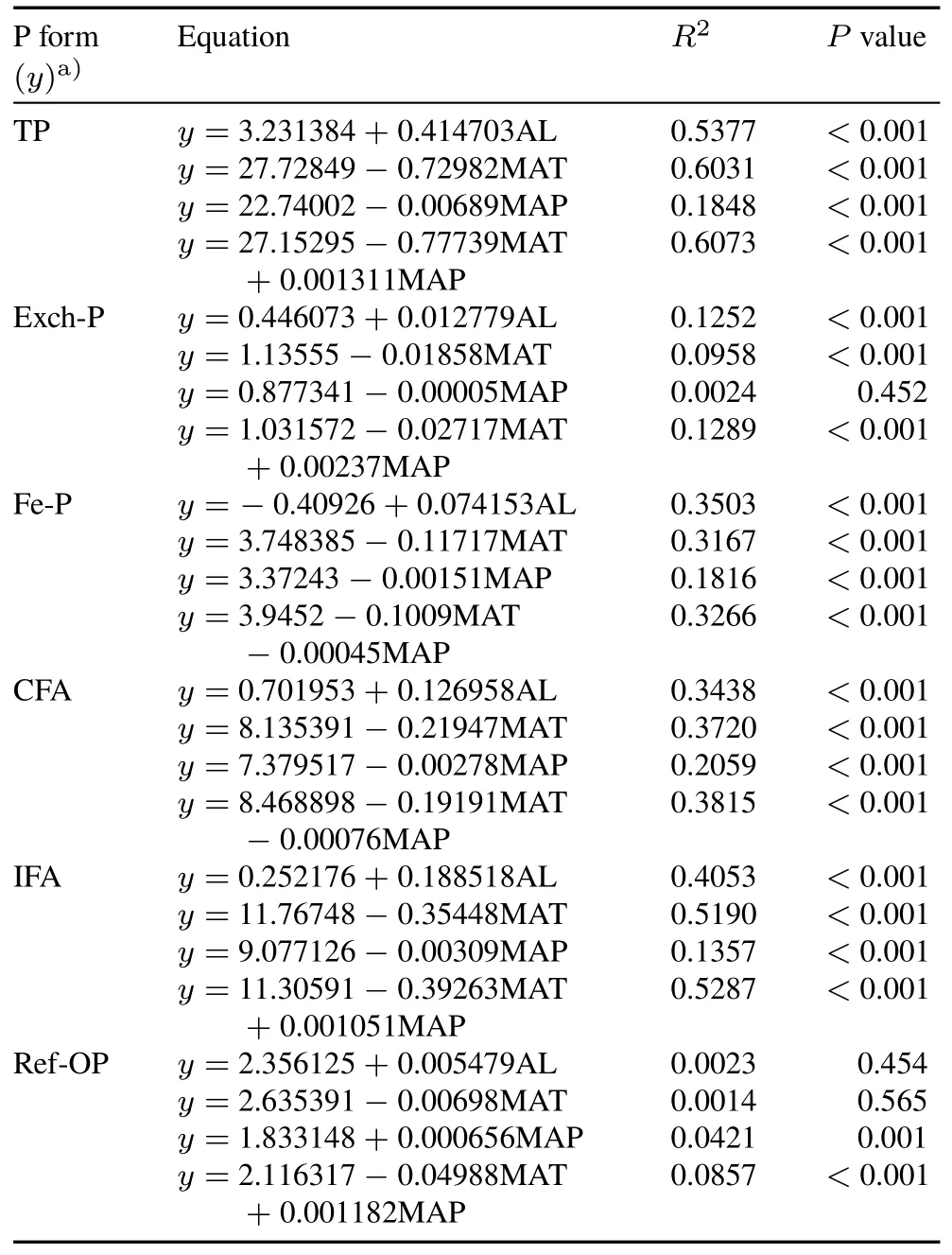
TABLE IMultiple regression equations obtained and associated R2 and P values describing the explanatory capability of each model for the relationships of different P forms with absolute latitude(AL,◦)and mean annual temperature(MAT,◦C)and precipitation(MAP,mm year−1)of the study sites
The contents of IFAs in soil and sediment vary from 0.17µmol g−1in tropical Indonesia(Levy and Schlesinger,1999)to 23.72µmol g−1on an Antarctic island(Berbel and Braga,2014).Similar to TP,IFAs are low in the tropics and high in the high-latitude regions.The IFA contents also increase with AL,showing a positive correlation(R2=0.4053 andP<0.001)(Table I,Fig.3).The abundance of IFAs relative to TP increases from 24% in the tropics to 44% in the high-latitude regions.In contrast,IFA contents decrease with MAT,showing a significant negative correlation(R2=0.5190,P<0.001)(Table I,Fig.3).This is in agreement with the observed high IFA contents in cold,high-latitude regions and low IFA contents in warm,subtropical regions,e.g.,about 0.3µmol g−1in Florida Bay,USA(Zhanget al.,2004).The IFA contents also show a negative correlation with MAP(R2=0.1357,P<0.001),indicating that the high IFA contents are associated with arid climate such as the Loess Plateau of northern China and low IFAs are associated with wet,tropical climate.The global pattern of IFAs reveals the climate as a dominant driving force in continental weathering of IFAs.It is well known that high temperature enhances weathering and dissolution of IFA to dissolved phosphate(Guidry and MacKenzie,2003),which is immediately assimilated by plants and soil microbes.Enhanced weathering and biological uptake result in low IFA content in soil and sediment.Since IFAs typically occur in fine particles,soil erosion induced by heavy precipitation can significantly drain IFAs from terrestrial surface.
The CFAs are carbonate-associated apatites of biological origin and most commonly occur in sedimentary phosphorites.In this dataset,the CFA contents vary from 0.23 to 18.77µmol g−1,typically accounting for about 30% of TP.Similar to TP and IFAs,CFAs significantly increase with AL and decreases with MAT and MAP(R2=0.3438,0.3720,and 0.2059,respectively,P<0.001)(Table I,Fig.3).The Fe-P contents vary from 0.05 to 11.5µmol g−1,typically accounting for about 20% of TP.Similar to TP,Fe-P significantly increased with AL and decreased with MAT and MAP(R2=0.3503,0.3167,and 0.1816,respectively,P<0.001)(Table I,Fig.3).The high degree of scatter reflects the ubiquitous,variable abundance of iron associated with variation in bedrock lithology in terrestrial surface environments.The Fe-P increase with AL is because TP increases with AL.It seems that TP(or exchangeable P(Exch-P))controls Fe-P and available Fe does not regulate the amount of Fe-P.This has been demonstrated in regional studies,for example,in Florida Bay,USA(Zhanget al.,2004;Zhang and Huang,2007).
The Ref-OP contents range from 0.22 to 10.1µmol g−1,typically accounting for about 20% of TP,vary little with AL or MAT(P>0.05),but increase with MAP(P=0.001),all showing significant scatter(R2=0.0024,0.0014,and 0.0421,respectively)(Table I,Fig.3).The higher Ref-OP contents in the temperate regions reflect higher biomass in this region,as this P pool is derived from and accumulated as a result of biological activity.In arid and semiarid environments,water availability can limit plant biomass,resulting in a small pool of Ref-OP(Brantleyet al.,2011;Margalefet al.,2017).The increasing trend of Ref-OP with MAP is in agreement with those of observations.
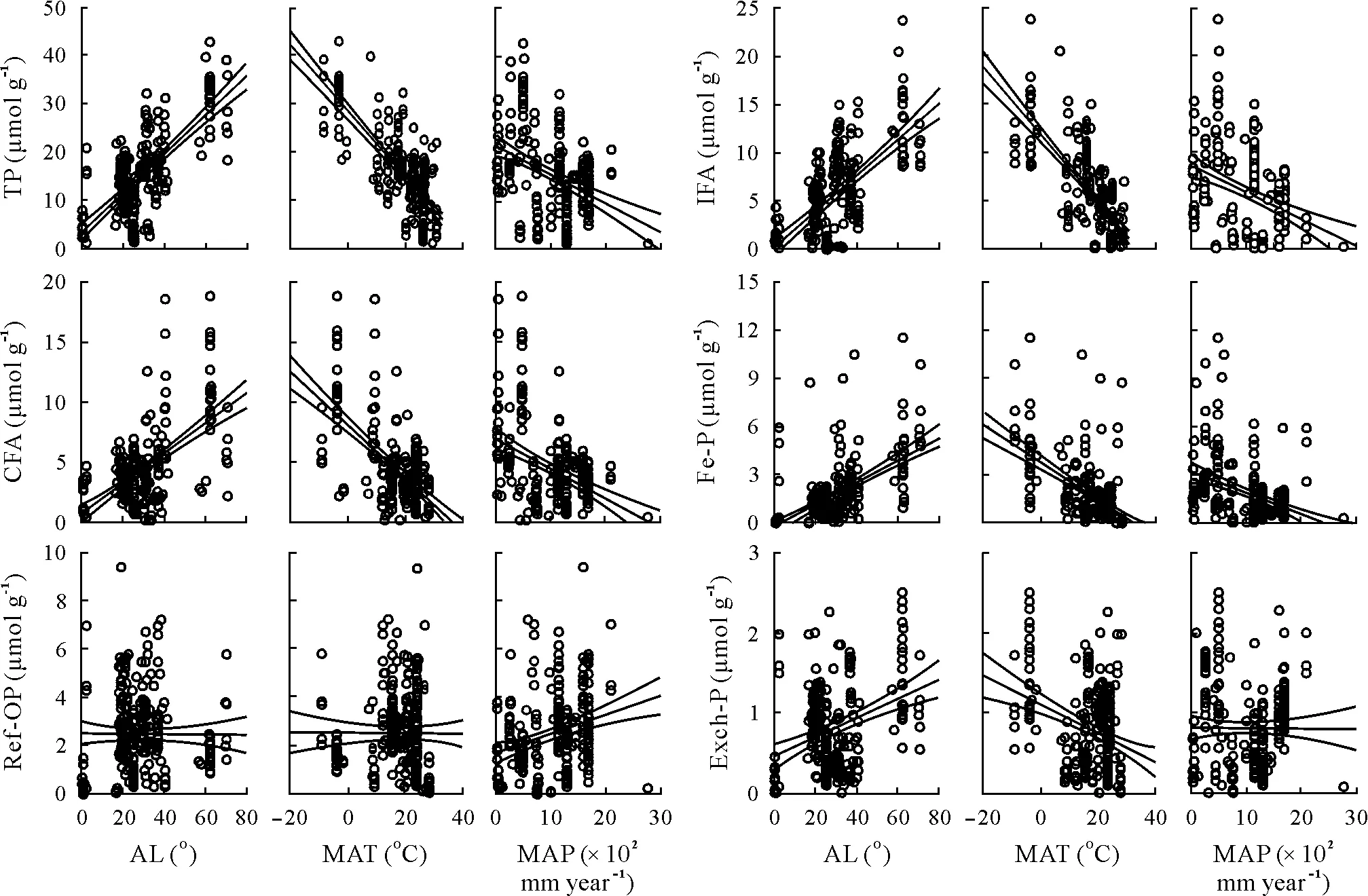
Fig.3 Relationships of total P(TP),igneous fluorapatite(IFA),carbonate fluorapatite(CFA)or francolite,Fe-bound P(Fe-P),refractory organic P(Ref-OP),and exchangeable P(Exch-P)contents with absolute latitude(AL),mean annual temperature(MAT),and mean annual precipitation(MAP),fitted by linear regression with 95% confidence intervals.
The Exch-P fraction represents the immediately bioavailable P pool in soil and sediment.This fraction varies from 0.01 to 2.52µmol g−1,typically accounting for less than 10% of TP.Similar to TP,the Exch-P contents increase with AL and decrease with MAT with significant scatter(R2=0.1252 and 0.0958,respectively)(Table I,Fig.3).The latitude and temperature trends of Exch-P are consistent with those of TP because the nearly constant proportions of Exch-P in TP have been observed worldwide.However,the significant scatter reflects that the other variables such as chemical composition and particle size of soil and sediment might also play roles other than TP.In contrast,Exch-P shows no significant correlation with MAP(a negligible slope of−0.00005,R2=0.0024,P=0.452)(Table I,Fig.3).
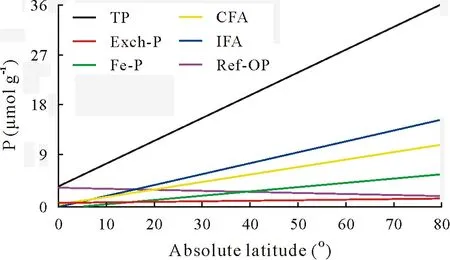
Fig.4 Average latitudinal gradients of total P(TP)and five different forms of P separated using the SEDEX method(Ruttenberg,1992).TP=total P;IFA=igneous fluorapatite;CFA=carbonate fluorapatite or francolite;Fe-P=Fe-bound P;Ref-OP=refractory organic P;Exch-P=exchangeable P.
With limited available SEDEX data,we have provided a broad-brush picture of global patterns of the terrestrial P biogeochemical cycle.A linear pattern has been observed between the P pool and AL,MAT,and MAP.Averaged latitudinal gradients for different forms of P are shown in Fig.4.The pools of TP,IFAs,CFAs,and Fe-P all increase with increasing AL.The TP contents increase from about 4µmol g−1in the tropics to about 36µmol g−1in the polar regions.The IFA pool is dominant from the subtropics to high-latitude regions,accounting for below 30% of TP in the subtropics and 42% in the high-latitude regions.The CFA pool is the second largest,ranging from 2µmol g−1in the tropics to 10µmol g−1in the polar regions.The ratios of CFAs to TP vary little with AL from 23% in the tropics to 30% in the high-latitude regions.The Fe-P pool accounts for less than 5% of TP in the tropics and about 15% of TP in the high-latitude regions.The Exch-P pool is the smallest,but represents the most bioavailable form of P in the surface environment,varying from 0.5 to 1.5µmol g−1and accounting for 10% of TP in the tropics and 4% of TP in the high-latitude regions due to relatively high TP in the cold regions.The Ref-OP pool is the sole fraction that shows no clear trend with AL.It has a global average content of 2.6µmol g−1and accounts for about 10% of TP in the temperate and high-latitude regions,but become a significant P form(30% of TP)in the tropics,where TP is typically low.The global patterns shown in Fig.4 are a result of the combined actions of physical erosion,chemical weathering,hydrological transport,biological uptake,and recycling of various P forms in the earth surface environment.We believe that the driving force behind all these actions is climate,which in turn is governed by a latitudinal gradient in the distribution of solar irradiance energy around the globe.
ACKNOWLEDGEMENT
This study was supported by the National Oceanic and Atmospheric Administration(NOAA)Ocean and Atmospheric Research,USA.The scientific results and conclusions,and any views or opinions expressed herein are those of the author and do not necessarily reflect the views of NOAA or Department of Commerce,USA.
杂志排行
Pedosphere的其它文章
- Notes to Authors
- Agricultural and environmental challenges in agroecosystems
- In Commemoration of Professor Tianren YU’s 100th Anniversary
- Microbial diversity assembled from series-diluted suspensions of diseasesuppressive soil determines pathogen invasion resistance
- Chemical and spectroscopic characteristics of humic acid from a clay loam soil in Ontario after 52 years of consistent fertilization and crop rotation
- Interactive effects of elevated CO2 and nitrogen fertilization levels on photosynthesized carbon allocation in a temperate spring wheat and soil system
